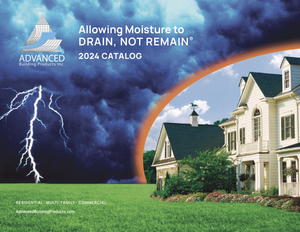Lean & Mean Cavity Wall Designs
By Keith Lolley, President
Advanced Building Products, Inc.
Creating space. Two simple words that have been a leading topic of conversation in the building industry for years. Over time, we have seen a number of innovations in cladding materials. I remember when our options were brick, wood, or vinyl. Things have changed, or should I say evolved. Some of these newer cladding materials are manufactured from absorptive materials, which means they will absorb moisture. There are positive attributes to these newer cladding materials; however, we need to be mindful that they will absorb moisture, which is why the topic of creating space within a wall system has been such a strong topic of conversation in recent years.
For the past twenty-six years I have given a number of AIA presentations around the country on moisture protection. Whether I am talking about cavity walls, single family, or multi-family wall applications, the importance of creating space has always been the theme. A substantial portion of the presentation has revolved around just how wide the airspace needs to be. Well, that all depends on what the designer is trying to achieve.
Recently there have been positive changes to the 2021 and 2024 building codes. To be more specific, Section R703.7.3.2 of the International Residential Code and Section 2510.6.2 of the 2021 International Building Code. Both codes now call for a five-millimeter capillary break to form an effective rainscreen wall assembly. Why five millimeters? It has been scientifically proven that five millimeters create enough of a capillary break to allow for the necessary drainage and ventilation within a wall system to keep the wall performing as originally intended. In the natural environment, there are positive and negative air pressures working against each other. The greater the difference in air pressure, the stronger the drawing power to force moisture into the wall system through the absorptive cladding where it would then remain trapped. When creating a rainscreen wall assembly, it is about neutralizing the air pressure between the outside and inside of the wall system. Introducing air into the wall space will neutralize the forces that otherwise would draw moisture from the outside through the absorptive cladding and into the inner workings of the wall system. This capillary break also helps reduce the vapor drive that otherwise could pull moisture from the inside livable space through and to the inside of the wall.
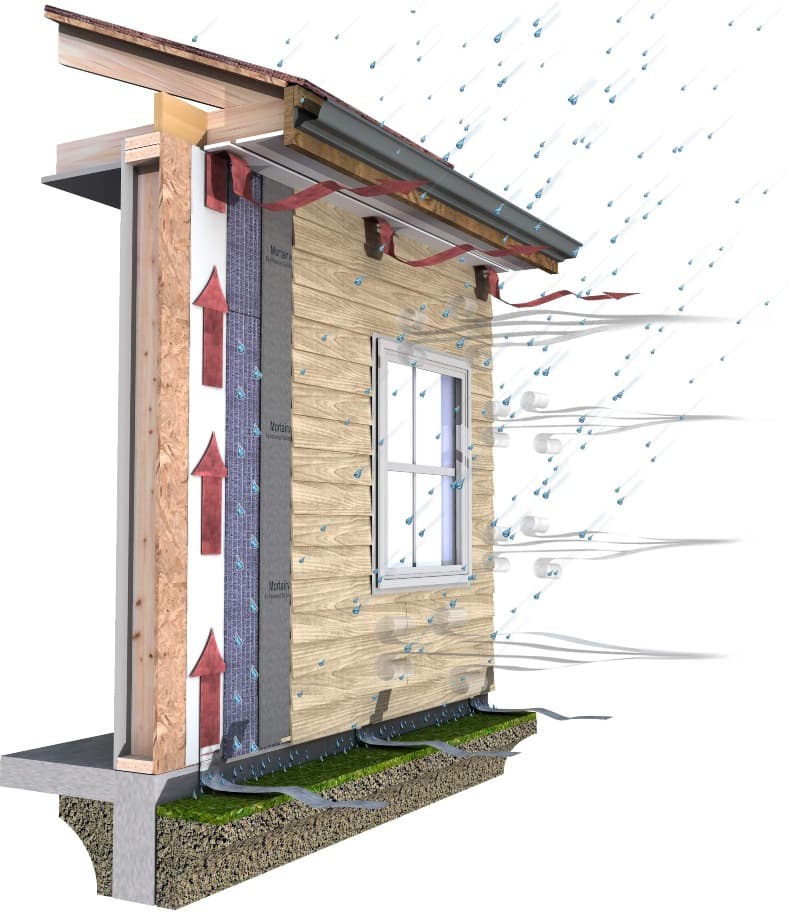
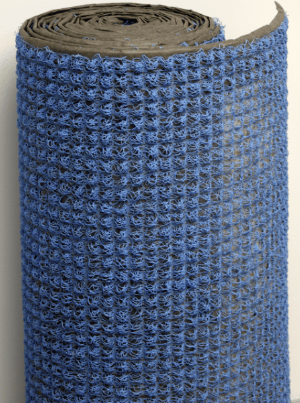 The best way to create this capillary break in residential and multi-family face sealed wall assemblies is to install a drainage and ventilation mat from the bottom of the wall all the way to the top. Code compliant drainage and ventilation mats should be assessed to ASTM E2925. This ASTM recommends three variations. Type A, which is an entangled matrix. Type B, which is a dimple sheet, and Type C, which is an engineered batten strip. By using any of these three types of products, the wall system goes from a face sealed wall assembly, which allows for minimal draining and essentially no ventilation, to an engineered rainscreen wall assembly, which provides optimal drainage and ventilation. This minor wall modification makes for a very formidable and price competitive wall system.
The best way to create this capillary break in residential and multi-family face sealed wall assemblies is to install a drainage and ventilation mat from the bottom of the wall all the way to the top. Code compliant drainage and ventilation mats should be assessed to ASTM E2925. This ASTM recommends three variations. Type A, which is an entangled matrix. Type B, which is a dimple sheet, and Type C, which is an engineered batten strip. By using any of these three types of products, the wall system goes from a face sealed wall assembly, which allows for minimal draining and essentially no ventilation, to an engineered rainscreen wall assembly, which provides optimal drainage and ventilation. This minor wall modification makes for a very formidable and price competitive wall system.
So, what about commercial cavity wall systems? The standard airspace in commercial cavity wall construction is two inches. The minimum airspace allowed per the building codes is one inch. Now let us consider code changes. Energy code changes to be more specific. Building designers are specifying outboard rigid insulation in various thicknesses. Sometimes as little as one-inch, and sometimes up to three-inches or more. Since masonry is an absorptive material, designers know the importance of keeping the airspace for proper drainage. To manage moisture intrusion, these masonry walls are designed with air/vapor barriers, through wall flashings, mortar deflection devices and weep vents. This design allows moisture that gets past the veneer, the ability to drain down and out of the wall before harm can be done. Once again, the topic of creating space comes up. As the cavity becomes filled with increased insulation, the wall still needs the intended airspace, which means a standard two-inch airspace now has two inches of outboard insulation added making the distance between the backup wall and back side of the brick veneer four inches. This is basic math, so what is my point? By meeting new energy code requirements, the cavity wall designs are becoming wider and wider. This means the through wall flashings will need a wider width. This adds cost, especially when using copper or stainless-steel flashing. The concrete foundation will now need to be wider, which is increasing the cost of the foundation. Additional engineering is sometimes called for now that the wall reinforcing must span a greater distance. Again, adding cost. Keep in mind, these design changes are often due to keeping a clear airspace so moisture that enters the veneer does not get trapped within the wall due to mortar droppings that fall from the head and bed joints during construction. What if there was a better way?
For the past thirty-five years, my company, Advanced Building Products, has been manufacturing mortar deflection products. For years we only manufactured these products in one inch or two-inch thickness. One-inch met the building code minimum, and two-inches met the industry standard. Now with code changes we have a variety of thicknesses, yet one inch is by far the best seller. Why? The standard cavity is two inches, right? The simple answer is cost savings.
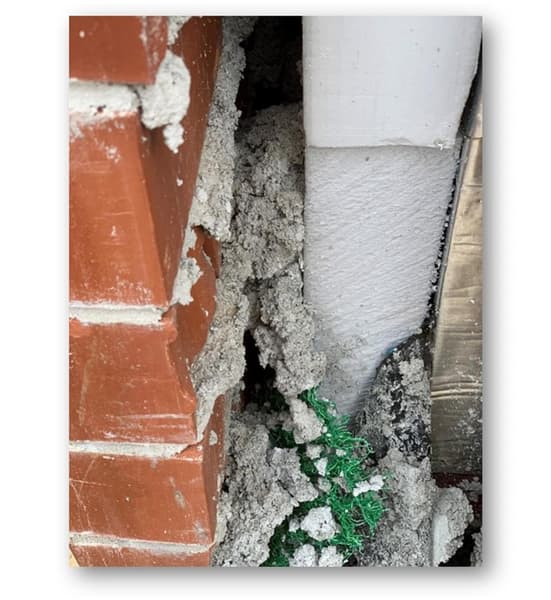

Exhibit A shows what happens when a mortar deflection intended for a one-inch airspace is installed in a two-inch airspace. What if there was a way to effectively build to the code minimum? There is. Products, such as Mortairvent®CW, by Advanced Building Products, are becoming increasingly specified. These products are all-wall mortar deflection products with a twist. When designed right, using all-wall mortar deflections will turn a drained cavity wall into a pressure neutralized engineered rainscreen wall assembly. Remember, a cavity wall is designed to manage moisture once it enters past the brick veneer. An engineered rainscreen wall neutralizes the air pressure, which controls the amount of moisture that enters the wall system.
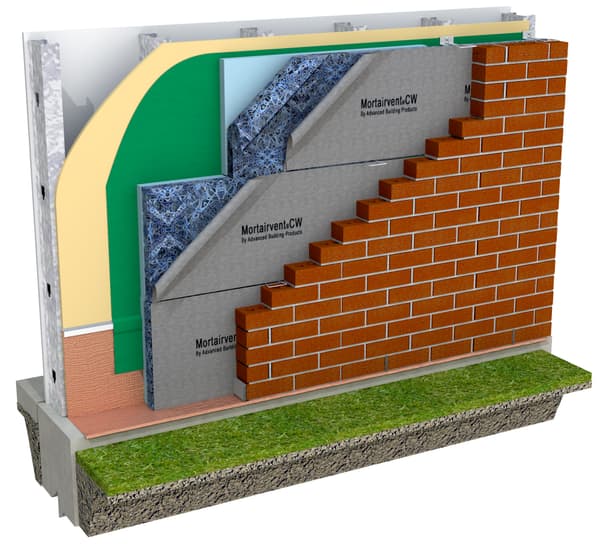

In Exhibit B, you will notice the entangled geomatrix filaments have a heat bonded filter fabric attached. This filter fabric acts as the mortar deflection. As excess mortar tries to seep into the cavity, it is blocked by this filter fabric forcing excess mortar out of the wall as opposed to falling into the airspace. The filter fabric allows moisture to pass through the fabric and drain freely down through the unobstructed geomatrix. The unobstructed pathway allows for the airspace to be constructed to the one-inch code minimum. This technique has been proven effective. Organizations such as the International Masonry Institute have even mentioned this design in their ASK IMI Newsletters and in presentations. By using this all-wall mortar deflection, the wall can easily be converted into a pressure neutralized rainscreen wall system. How? By placing weep vents at the bottom of the wall and at every floor location, the wall system will function like a car engine. The wall will have an intake (the weeps at the bottom of the wall) and an exhaust (the weeps at floor locations). This will allow air to move in a convective fashion, not only draining excess moisture, but helping dry the wall and all components within the wall system. So why not just run the Mortairvent®CW, or other all-wall mortar deflection products directly to the top of the wall? Two words…fire protection. When establishing the proper capillary break, or airspace, building science professionals had to consider the stack or chimney effect in case of fire. Airspaces consisting of one inch or less tend to not allow enough oxygen into the wall system for flames to propagate. Knowing this, why is the standard airspace two inches in the industry? Most commercial walls are designed with fire blocking at every floor level to help contain, or slow down flame spread. This is why all-wall mortar deflections are often manufactured in sixteen-inch widths. They fit in between wall ties and are installed section by section as the veneer is being installed. These commercial wall systems become compartmentalized, which makes them even more effective with internal convective drying.
In closing, the use of all-wall mortar deflection products, such as Mortairvent®CW, by Advanced Building Products will provide the following positive results:
- Turns a drainage cavity wall into a pressure neutralized rainscreen wall assembly.
- Will help reduce through wall flashing costs.
- Will help reduce wall reinforcing costs.
- Will help reduce foundation costs.
- Will shrink the carbon footprint of the structure.
- Could increase livable space based on design.
One last thought. If shrinking the width of the wall is not a concern, the use of an all-wall mortar deflection could allow room for additional rigid outboard insulation, which will add to the wall’s overall energy efficiency.
For more information, please visit www.advancedbuildingproducts.com.



